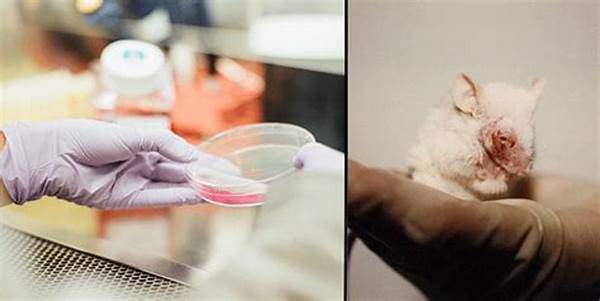Hey there, fabulous readers! Today, we’re going to chat about something that’s been buzzing around the scientific community for ages: animal testing. Sure, it’s helped us learn heaps about biology and develop life-saving treatments. But, let’s be real, the ethical concerns and technological innovations are steering us towards some fab alternatives. So, grab your favorite drink, get comfy, and let’s dive into the world of alternatives to animal experimentation!
Read Now : How To Use Image Watermark Generators
Technological Marvels in Action
You know how everyone says technology is taking over the world? Well, it’s doing something super cool in the science realm by providing fantastic alternatives to animal experimentation. Picture this: researchers now have access to funky tech gadgets that mimic human organs on chips! These tiny chips mimic real human organs’ functions, giving scientists a front-row seat to how our bodies would react to certain drugs or treatments without having to rely on poor animals.
With organ-on-chip technology, scientists can observe cellular behavior and drug interactions just like they would in a real human organ. This tech marvel offers insights into the human body that animal models sometimes just can’t replicate. Meanwhile, there are computer-simulated models and algorithms working their magic too! They can predict how diseases might progress or how medications might work in humans, cutting down the need for animal experiments. Plus, with virtual reality models becoming more sophisticated, the future looks bright for reducing animal testing.
And let’s not skip over the groundbreaking advancements in stem cell research. These alternatives to animal experimentation are paving the way for testing diseases or drugs with actual human cells. All these tech-based methods not only ensure accuracy and efficiency but also align with the ethical push to reduce animal testing more.
Exploring More Alternatives
1. Tissue Engineering: Scientists are creating functional human tissues in labs to test drugs, reducing reliance on animal subjects.
2. Microdosing: Small, safe doses of drugs tested on humans give insights without animal interventions.
3. In Silico Models: These are computer-based simulations that predict drug effects, reducing the need for animal testing.
4. Bioprinting: Advances in 3D printing now allow the creation of actual human tissues, offering new paths in drug discovery.
5. Zebrafish Embryo Testing: Provides a more humane testing method and is gaining traction as a potential alternative.
Why the Shift is Important
Switching to alternatives to animal experimentation isn’t just about keeping adorable bunnies out of harm’s way (though that’s a great reason!). There’s a practical side to it, too. Human biology is distinct, which means animal tests sometimes provide data that isn’t relevant to humans. That’s why these new methods, which are human-based, help ensure that the results are more accurate and directly applicable to people.
Moreover, adopting these alternatives can lead to faster discoveries at potentially lower costs. Organ-on-chip, models, or stem cell testing often deliver data quickly and with more precision than traditional animal testing methods. For researchers, this is a win-win because they get to make accurate discoveries faster while also aligning with emerging ethical standards.
On top of that, as consumers, we’re becoming more conscious of the products we use and their backstories. Knowing that our skincare or medication comes from innovative, animal-free methods certainly brings about peace of mind. Companies recognizing this shift towards ethical production are seeing the benefits, too, both in consumer trust and in advancing their research prowess.
The Path Forward for Ethical Science
Here’s the scoop, folks: the journey towards alternatives to animal experimentation is a dynamic one. Evolving every day with new breakthroughs and discoveries, the road is getting exciting. With more researchers advocating for cruelty-free scientific processes, the momentum leans towards a more ethical and efficient way of conducting experiments.
1. Collaboration is key—scientists from all over the world are uniting to share findings on alternatives, helping progress faster.
2. Funding is being redirected to alternatives research, signifying a change in the system.
3. Institutions are incorporating ethical science into their curricula, training the next-gen scientists in cruelty-free practices.
4. Regulatory bodies are recognizing and approving alternative methods, validating their use in real-world applications.
Read Now : Watermark Editor Without Cost
5. Governments are implementing laws to promote ethical research, slowly pushing the needle forward.
6. Public awareness campaigns highlight the importance of transitioning away from animal testing.
7. Companies pledge to adopt non-animal testing methods because it’s more than a trend—it’s the future.
8. Awards and recognitions are encouraging cruelty-free innovations in research fields.
9. Transparency in research practices allows consumers and supporters to track advancements in ethical science.
10. And finally, we’re all part of the change! By supporting and advocating for these alternatives, everyone can contribute to a more humane future in science.
A Brighter Future with Ethical Research
Let’s talk about the future, shall we? The horizon is looking all sorts of optimistic when it comes to alternatives to animal experimentation. In the years to come, we can anticipate a landscape where cruelty-free research is not just the norm but is celebrated. As technology continues to elevate, we can rest easy knowing animals have more rights and that their lives matter in the realm of science.
Businesses and consumers alike are tilting towards a preference for ethical choices. With a genuine shift in public demand, companies are making conscious decisions to transition to cruelty-free testing methods. And it doesn’t just stop at pharmaceuticals; cosmetics and food industries are part of this empathetic revolution too.
Honestly, what we’re experiencing is an era where ethics meet innovation. A place where technological advancements are not just leaving a mark but also creating a warmer, kinder scientific and consumer world. Let’s continue championing the necessary shift when thinking about alternatives to animal experimentation—because, remember, progress doesn’t just come from science; it comes from the collective empathy of the society, science community included.
The Cool Side of Alternatives: Slang Edition
Yo, peeps! Let’s get real for a second. The vibe with alternatives to animal experimentation is buzzing in the science world. Why? ‘Cause it’s all about that combo of high-tech swagger and saving our furry, scaly, and feathery friends. It’s like science finally got woke, you know?
Organ-on-chip is like the Tesla of the science lab. Instead of test tubes and cages, we’ve got these mind-blowing chips acting like mini-human organs. Bonkers, right? And if you think that’s wild, check out the virtual reality setups and computer models turning experiments into next-level sci-fi stuff. Plus, with all this, we’re ditching animal testing paths ’cause we’re less about the past and all about that futuristic, empathetic science swag. Keep the good vibes rolling!
Let’s Wrap Up
In conclusion, stepping away from animal experimentation isn’t just some passing trend; it’s a steadfast movement. Alternatives to animal experimentation offer a smarter, more humane way of conducting research. These methods are powerful in demonstrating that we can achieve precise scientific inquiry while also honoring ethical considerations.
Adopting alternative methods not only solves ethical dilemmas but also progresses research efficiency and accuracy. As the scientific community continues to push for innovation, integrating technology into research marks an exciting time for future discoveries. The trajectory is clear: the more we invest in these alternatives, the sweeter the reward will be for science, industry, and society at large. Together, let’s support and cheerlead for a world that respects all creatures big and small, making room for compassion and innovation, hand in hand.



